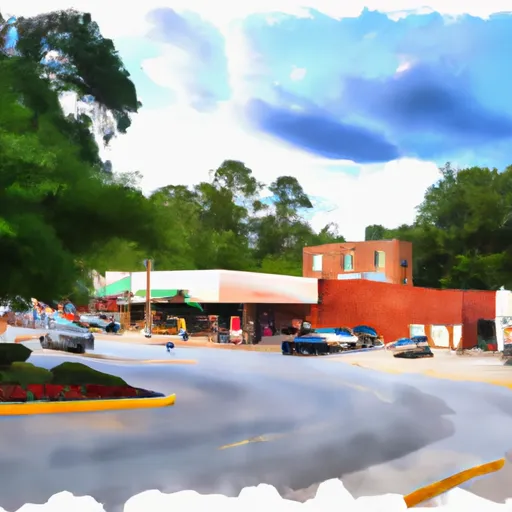-
 Snoflo Premium
Snoflo Premium
Get unlimited access to all our content
With no Ad interruptions! - Start Your Free Trial Login with existing account
Lyerly
Eden Index
Climate
7.7
•
Recreation
4.5
•
Community
0.9
•
Safeguard
4.9/10

Lyerly, Georgia is a small town located in Chattooga County in the northwest part of the state. The climate in Lyerly is classified as humid subtropical, characterized by hot and humid summers, mild winters, and a moderate amount of rainfall throughout the year.
Hydrology constituents in Lyerly primarily include the Chattooga River, which flows nearby and offers opportunities for fishing, kayaking, and canoeing. The river is known for its clean water and scenic beauty, attracting outdoor enthusiasts.
Lyerly and its surrounding areas provide numerous outdoor recreation opportunities. The nearby Chattahoochee National Forest offers hiking trails, camping sites, and wildlife viewing opportunities. Additionally, residents and visitors can explore the picturesque John's Mountain Wildlife Management Area, where activities such as hunting, fishing, and hiking are popular.
Overall, Lyerly, Georgia is a charming town that benefits from its proximity to natural resources like the Chattooga River and national forest areas. Its favorable climate allows for year-round outdoor activities, making it an attractive destination for nature lovers and adventure seekers.
What is the Eden Index?
The Snoflo Eden Index serves as a comprehensive rating system for regions, evaluating their desirability through a holistic assessment of climate health, outdoor recreation opportunities, and natural disaster risk, acknowledging the profound impact of these factors on livability and well-being.
Climate Health Indicator (CHI): 7.7
Lyerly receives approximately
1375mm of rain per year,
with humidity levels near 83%
and air temperatures averaging around
16°C.
Lyerly has a plant hardyness factor of
7, meaning
plants and agriculture in this region tend to thrive during the non-winter months.
By considering the ideal temperature range, reliable water supplies, clean air, and stable seasonal rain or snowpacks, the Climate Health Indicator (CHI) underscores the significance of a healthy climate as the foundation for quality living.
A healthy climate is paramount for ensuring a high quality of life and livability in a region, fostering both physical well-being and environmental harmony. This can be characterized by ideal temperatures, reliable access to water supplies, clean air, and consistent seasonal rain or snowpacks.
Weather Forecast
Streamflow Conditions
Coosa-Tallapoosa
Area Rivers
Coosa-Tallapoosa
Snowpack Depths
Coosa-Tallapoosa
Reservoir Storage Capacity
Coosa-Tallapoosa
Groundwater Levels
Recreational Opportunity Index (ROI): 4.5
The Recreational Opportunity Index (ROI) recognizes the value of outdoor recreational options, such as parks, hiking trails, camping sites, and fishing spots, while acknowledging that climate plays a pivotal role in ensuring the comfort and consistency of these experiences.
Access to outdoor recreational opportunities, encompassing activities such as parks, hiking, camping, and fishing, is crucial for overall well-being, and the climate plays a pivotal role in enabling and enhancing these experiences, ensuring that individuals can engage in nature-based activities comfortably and consistently.
Camping Areas
| Campground | Campsites | Reservations | Toilets | Showers | Elevation |
|---|---|---|---|---|---|
| Amity | None | 689 ft | |||
| Coleman Lake Rec Area | 147 | 1,182 ft | |||
| Pine Glen | 31 | 990 ft | |||
| Chewacla State Park | None | 516 ft | |||
| Big Oak Gap Hunter Camp | 10 | 1,404 ft | |||
| Spring Villa Campground | 24 | 604 ft | |||
| Coosa River County Park | None | 591 ft | |||
| Tally Valley County Park | None | 1,117 ft | |||
| James H Sloppy Floyd State Park | None | 720 ft | |||
| Burnt Village | 120 | 687 ft |
Nearby Ski Areas
Catastrophe Safeguard Index (CSI):
The Catastrophe Safeguard Index (CSI) recognizes that natural disaster risk, encompassing floods, fires, hurricanes, and tornadoes, can drastically affect safety and the overall appeal of an area.
The level of natural disaster risk in a region significantly affects safety and the overall livability, with climate change amplifying these risks by potentially increasing the frequency and intensity of events like floods, fires, hurricanes, and tornadoes, thereby posing substantial challenges to community resilience and well-being.
Community Resilience Indicator (CRI): 0.9
The Community Resilience Indicator (CRI) recognizes that education, healthcare, and socioeconomics are crucial to the well-being of a region. The CRI acknowledges the profound impact of these elements on residents' overall quality of life. By evaluating educational resources, healthcare accessibility, and economic inclusivity, the index captures the essential aspects that contribute to a thriving community, fostering resident satisfaction, equity, and social cohesion.

